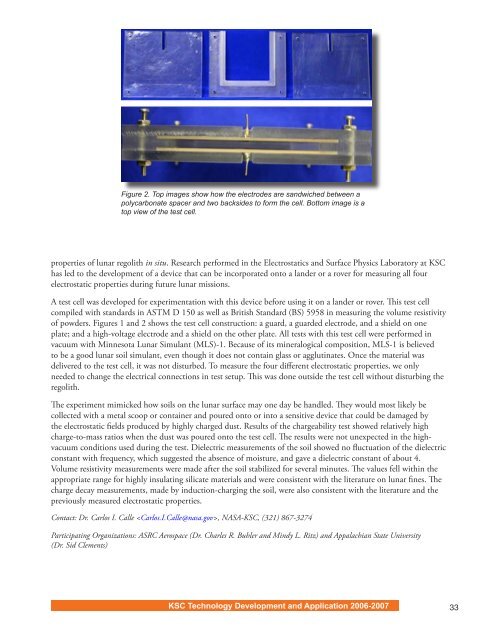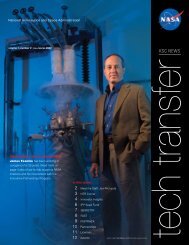2006-2007 - Kennedy Space Center Technology Transfer Office
2006-2007 - Kennedy Space Center Technology Transfer Office
2006-2007 - Kennedy Space Center Technology Transfer Office
- No tags were found...
You also want an ePaper? Increase the reach of your titles
YUMPU automatically turns print PDFs into web optimized ePapers that Google loves.
Figure 2. Top images show how the electrodes are sandwiched between apolycarbonate spacer and two backsides to form the cell. Bottom image is atop view of the test cell.properties of lunar regolith in situ. Research performed in the Electrostatics and Surface Physics Laboratory at KSChas led to the development of a device that can be incorporated onto a lander or a rover for measuring all fourelectrostatic properties during future lunar missions.A test cell was developed for experimentation with this device before using it on a lander or rover. This test cellcompiled with standards in ASTM D 150 as well as British Standard (BS) 5958 in measuring the volume resistivityof powders. Figures 1 and 2 shows the test cell construction: a guard, a guarded electrode, and a shield on oneplate; and a high-voltage electrode and a shield on the other plate. All tests with this test cell were performed invacuum with Minnesota Lunar Simulant (MLS)-1. Because of its mineralogical composition, MLS-1 is believedto be a good lunar soil simulant, even though it does not contain glass or agglutinates. Once the material wasdelivered to the test cell, it was not disturbed. To measure the four different electrostatic properties, we onlyneeded to change the electrical connections in test setup. This was done outside the test cell without disturbing theregolith.The experiment mimicked how soils on the lunar surface may one day be handled. They would most likely becollected with a metal scoop or container and poured onto or into a sensitive device that could be damaged bythe electrostatic fields produced by highly charged dust. Results of the chargeability test showed relatively highcharge-to-mass ratios when the dust was poured onto the test cell. The results were not unexpected in the highvacuumconditions used during the test. Dielectric measurements of the soil showed no fluctuation of the dielectricconstant with frequency, which suggested the absence of moisture, and gave a dielectric constant of about 4.Volume resistivity measurements were made after the soil stabilized for several minutes. The values fell within theappropriate range for highly insulating silicate materials and were consistent with the literature on lunar fines. Thecharge decay measurements, made by induction-charging the soil, were also consistent with the literature and thepreviously measured electrostatic properties.Contact: Dr. Carlos I. Calle , NASA-KSC, (321) 867-3274Participating Organizations: ASRC Aerospace (Dr. Charles R. Buhler and Mindy L. Ritz) and Appalachian State University(Dr. Sid Clements)KSC <strong>Technology</strong> Development and Application <strong>2006</strong>-<strong>2007</strong>33













